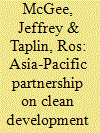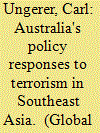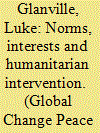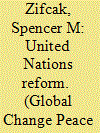| Srl | Item |
| 1 |
ID:
074353


|
|
|
|
|
| Publication |
2006.
|
| Summary/Abstract |
The Asia-Pacific Partnership on Clean Development and Climate (AP6) has been marketed as an innovative new approach to international climate change policy that is complementary to the existing Kyoto regime. It is important to closely examine these claims of complementarity, given the two nations that were central to the formation of the AP6, the United States and Australia, have both expressly repudiated the Kyoto process. The difficulty involved in this exercise is in separating political rhetoric regarding complementarity from the reality of how the AP6 will likely impact upon the effectiveness of the Kyoto regime. This article discusses the AP6 and the various claims as to complementarity with Kyoto made during its formation in July 2005 and inaugural meeting in January 2006. For the purpose of analyzing these claims of complementarity five key features of the content of the AP6 are identified for comparison with Kyoto. Stokke's theory of regime interplay is used to assess how each of the five key features of the AP6 will likely impact upon the effectiveness of Kyoto. This analysis indicates that at fundamental levels of regime interaction the AP6 has significant potential to obstruct the effectiveness of Kyoto as currently framed. The conclusion to be drawn from this analysis is that the claims by AP6 parties as to complementarity with Kyoto are only defensible at a shallow ideational level with significant obstruction likely at more fundamental levels of regime interaction. The reality is that the AP6 offers a competing regime in international climate change policy that at the very least has significant potential to affect the future shape of Kyoto.
|
|
|
|
|
|
|
|
|
|
|
|
|
|
|
|
| 2 |
ID:
074354


|
|
|
| 3 |
ID:
074352


|
|
|
|
|
| Publication |
2006.
|
| Summary/Abstract |
A number of constructivist and English school scholars have investigated the extent to which humanitarian intervention is allowed and legitimized by international society. In other words, they have examined the nature and strength of a norm permitting humanitarian intervention. It is the contention of this article that another norm of humanitarian intervention-parallel but discrete-has been neglected. It is argued that ideas and beliefs shared by some members of international society not only permit intervention but prescribe it in certain circumstances and this has been largely ignored in the literature. By focusing on questions of when, where and why humanitarian action is permitted, scholars have neglected to develop theoretical explanations for the significant inconsistencies in humanitarian action that can be observed in the world. States do not intervene to prevent human rights violations simply because they are allowed to. By considering when and where humanitarian action is prescribed, and the interplay of this prescription with the self-interests of states, we can begin to understand why states respond to some grave violations of human rights and not others. The article concludes with an analysis of the power of the prescriptive norm to explain the increased instances of humanitarian intervention since the end of the Cold War and an assessment of the present state of the norm.
|
|
|
|
|
|
|
|
|
|
|
|
|
|
|
|
| 4 |
ID:
074351


|
|
|
|
|
| Publication |
2006.
|
| Summary/Abstract |
When the United Nations (UN) Secretary-General, Kofi Annan, introduced his report 'In Larger Freedom' in March 2005, he set the organization on a path to pursue perhaps the most ambitious program for its reform since 1945. As part of that program, the Secretary-General proposed major changes to three key UN bodies: The Security Council, the General Assembly and the Commission for Human Rights. This article traces the progress of attempts to restructure these organs in the lead up to and following the World Leaders' Summit held at the UN in New York in September 2005. It is argued that, while some incremental institutional changes were effected at the Summit, the larger ends of the reform program were frustrated by the inability of the North and the South to agree on appropriate ways forward. This in turn reflected the radically different visions the contending parties had of the organization's nature and fundamental priorities.
|
|
|
|
|
|
|
|
|
|
|
|
|
|
|
|